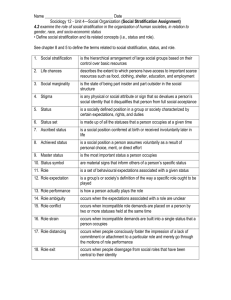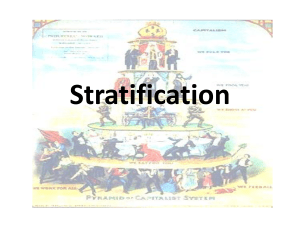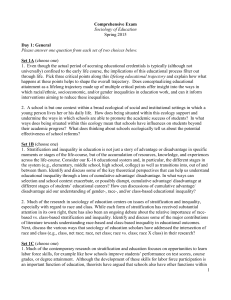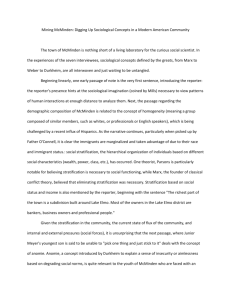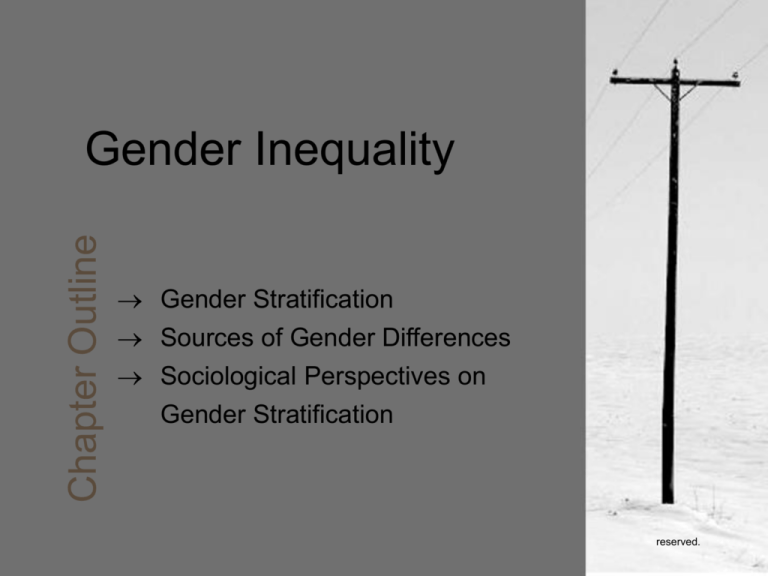
Chapter Outline
Gender Inequality
Gender Stratification
Sources of Gender Differences
Sociological Perspectives on
Gender Stratification
reserved.
Discussion
• Why does gender inequality
exist?
• Are some places more prone to
these inequalities than others?
• How can inequalities between
males and females cause
problems?
reserved.
Copy And Complete The
Following:
Throughout the presentation, sort your ideas into each of the
5 categories below to show what inequalities exist between
each category.
Culture
Work/
Education
Use Of
Men/Women
Diseases
MEDC’s/LEDC’s
reserved.
Definition of Terms
Sex – whether one is genetically male
or female; determines role in
reproduction
Gender – sociological distinction
between males and females
Gender identity – one’s self-concept
of being male or female
Gender roles – sets of cultural
expectations about the behavior
each sex should exhibit
reserved.
Gender Stratification
Sexism
• Individual level – the belief that one sex
is superior to the other
– Inherent biological differences mean
that men and women naturally have
different roles
– These roles are the primary cause of
differential distribution of power,
status, and income
• Institutional level – policies, procedures,
and practices that produce unequal
outcomes for men and women
reserved.
Gender Stratification
Are women a minority group?
Five properties of a minority group
• Experiences discrimination from a dominant
group and lacks power to change the
situation
• Distinguishing physical or cultural traits
• Self-conscious social group; sense of group
identity
• Generally not voluntary
• Typically endogamous
reserved.
Gender Stratification
Patriarchy
• A system of social organization in
which men have a
disproportionate share of power
• Lorber: early societies were
egalitarian
• Davis-Kimball: archaeological
evidence of female military and
social power
reserved.
Gender Stratification
World Gender Inequality
• U.S. State Department Annual Human
Rights Report (2006) – 196 nations
• Sex trade and forced labor (e.g.,
Ghana)
• M. East and N. Africa – honor killings
• Underage prostitution
• Sex-selective breeding
• Female circumcision
• Literacy and education
reserved.
Gender Stratification
U.S. Gender Inequality
• Today, marriage and family have
become less of an organizing force in
the lives of contemporary women
• Families today likely to delay
childbearing
• U.S. women’s labor-force
participation: 59.2% (2004)
• More than 60% of women with
children under the age of one are
employed
reserved.
Disparities in Earnings Remain Significant
Source: U.S. Census Bureau, March Current Population Surveys, available at:
http://www.census.gov/hhes/income/histinc/p36ar.html.
Gender Stratification
reserved.
Gender Stratification
Disparities in Earnings Remain Significant
(continued)
Source: U.S. Census Bureau, Current Population Survey, 2005 Annual Social and Economic Supplement,
available at: http://pubdb3.census.gov/macro/032005/perinc/new03_000.htm.
reserved.
Gender Stratification
U.S. Gender Inequality
• The Glass Ceiling
– Number of women top executives
and board directors increased over
the years, but positions at the top
still elude women executives
• Disparities in Pay
– Women earn less than men
reserved.
Gender Stratification
• The Second Shift
– The burden of housework falls
disproportionately on women,
working or not
• Career Patterns: Out of Sync with
Family Life
– Women who have children
encounter substantial career
disadvantages
– Equal opportunity for women in
public sphere remains substantially
frustrated by gender-role
differentiation within the family
reserved.
Gender Stratification
• Sexual Harassment and Rape
– Sexual harassment remains
common workplace hazard
– Rape is the most violent form of
sexual victimization
– Culture and gender inequality
influence the prevalence of rape
and sexual aggression
reserved.
Gender Stratification
• Politics and Government
– Number of women in politics in U.S.
increased in recent years
– Still difficult
• Low “supply” of candidates
• Low “demand” for female candidates
• Ideology affects women’s political
representation
• The Women’s Movement
– Substantial impact on way
Americans think and act; legal and
social equality
reserved.
Gender Stratification
• Persistence and Change
– Opportunities for women changed
dramatically over the past several
decades
– Women are still significantly
disadvantaged
– As more women reach positions of
economic, political, and social
power, changes may occur at more
rapid pace
reserved.
Sources of Gender
Differences
• Gender and Biology
– Maccoby and Jacklin (1974)
• Beginning about age 11, girls show
greater verbal ability than boys
• Boys are superior to girls on visualspatial tasks in adolescence and
adulthood
• At about age 12 to 13, boys move
ahead in mathematical ability
• Males are more aggressive
– Hyde (2005) – picture not that simple
reserved.
Sources of Gender
Differences
• Gender and Culture
– All are born into societies with wellestablished cultural guidelines for
behavior of men and women
– Great variation in gender roles from
one society to another
– Gender roles largely a matter of
social definition and socially
constructed messages
reserved.
Sociological Perspectives
on Gender Stratification
The Functionalist
Perspective
• Gender division of labor retained
because it promoted the survival
of the species
• Critics say this view becomes
powerful justification for the
existence of gender inequality
reserved.
Sociological Perspectives
on Gender Stratification
The Conflict Perspective
• Gender inequality benefits men,
so they attempt to perpetuate it
– Exploitation of labor
– Availability of sexual gratification
– Availability of tools for procreation
• Acker (1992): production >
reproduction
reserved.
Sociological Perspectives
on Gender Stratification
The Interactionist
Perspective
• Gender is socially constructed
and internally based
• Societal behavior follows internal
meanings of gender
• Example: linguistic usages of
gender terms such as “men”,
“he”, “she”, “boys”, and “girls”
reserved.




